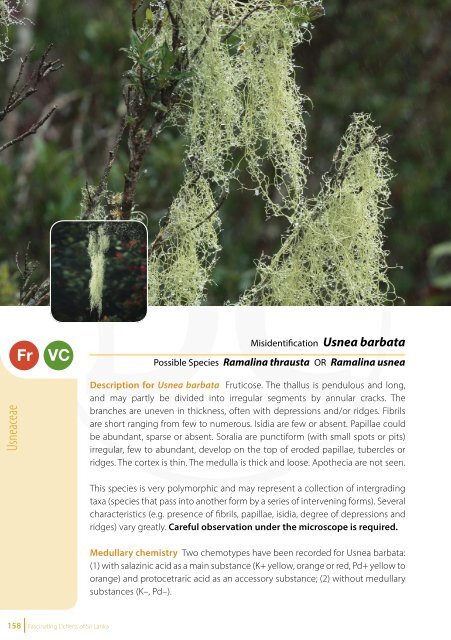Create successful ePaper yourself
Turn your PDF publications into a flip-book with our unique Google optimized e-Paper software.
Usneaceae<br />
Fr<br />
VC<br />
Misidentification Usnea barbata<br />
Possible Species Ramalina thrausta OR Ramalina usnea<br />
Description for Usnea barbata Fruticose. The thallus is pendulous and long,<br />
and may partly be divided into irregular segments by annular cracks. The<br />
branches are uneven in thickness, <strong>of</strong>ten with depressions and/or ridges. Fibrils<br />
are short ranging from few to numerous. Isidia are few or absent. Papillae could<br />
be abundant, sparse or absent. Soralia are punctiform (with small spots or pits)<br />
irregular, few to abundant, develop on the top <strong>of</strong> eroded papillae, tubercles or<br />
ridges. The cortex is thin. The medulla is thick and loose. Apothecia are not seen.<br />
Most <strong>of</strong> the Usnea species collected from <strong>Sri</strong> <strong>Lanka</strong> are identified as Usnea<br />
barbata by most <strong>of</strong> the collectors, but is not in actuality the aforementioned<br />
species. The lichen Usnea barbata has been referred to as a common lichen in<br />
Horton Plains in the historical records <strong>of</strong> hunters and explorers. However, this is<br />
a misidentification.<br />
Status Recorded as a very common species especially at Horton Plains as “old<br />
man’s beard” lichen. Further studies using molecular, morphology and chemistry<br />
is recommended for the correct identification <strong>of</strong> the Usnea and Ramalina species<br />
in Horton Plains and similar habitats.<br />
Usneaceae<br />
This species is very polymorphic and may represent a collection <strong>of</strong> intergrading<br />
taxa (species that pass into another form by a series <strong>of</strong> intervening forms). Several<br />
characteristics (e.g. presence <strong>of</strong> fibrils, papillae, isidia, degree <strong>of</strong> depressions and<br />
ridges) vary greatly. Careful observation under the microscope is required.<br />
Medullary chemistry Two chemotypes have been recorded for Usnea barbata:<br />
(1) with salazinic acid as a main substance (K+ yellow, orange or red, Pd+ yellow to<br />
orange) and protocetraric acid as an accessory substance; (2) without medullary<br />
substances (K–, Pd–).<br />
Habitat Usnea barbata is mostly restricted to humid high elevation forests as<br />
a corticolous species. Reported in Europe: Austria, Bulgaria, Czech Republic,<br />
Denmark, Estonia, Finland, Germany, Italy, Latvia, Lithuania, Norway, Poland,<br />
Romania, Russia, Slovakia, Slovenia, Spain, Sweden, Switzerland, Ukraine and<br />
Estonia. However, it is worth noting that this species has not been recorded in<br />
India, Nepal or other South Asian regions.<br />
Locations Historical identification <strong>of</strong> locations lists Horton Plains and the<br />
Nuwara Eliya district.<br />
158 <strong>Fascinating</strong> <strong>Lichens</strong> <strong>of</strong> <strong>Sri</strong> <strong>Lanka</strong><br />
<strong>Fascinating</strong> <strong>Lichens</strong> <strong>of</strong> <strong>Sri</strong> <strong>Lanka</strong> 159















